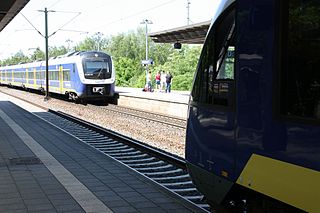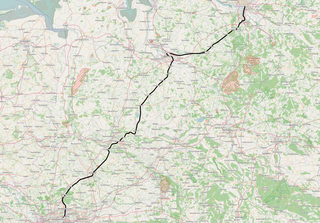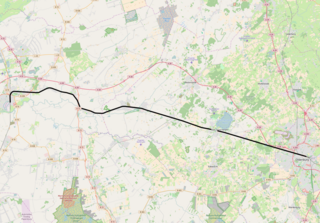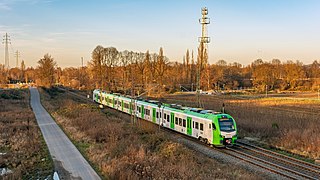
The Zurich S-Bahn system is a network of rail lines that has been incrementally expanded to cover the ZVV area, which comprises the entire canton of Zurich and portions of neighbouring cantons, with a few lines extending into or crossing the territory of southern Germany. The network is one of many commuter rail operations in German speaking countries to be described as an S-Bahn. The lines connect with services of Aargau S-Bahn to the West, Basel S-Bahn and Schaffhausen S-Bahn to the North, St. Gallen S-Bahn to the East, and Lucerne S-Bahn/Zug Stadtbahn to the South, as well as with InterCity, InterRegio and RegioExpress services at major junction stations.

Loxstedt is a municipality in the district of Cuxhaven in Lower Saxony, Germany. It is situated south of Bremerhaven.

Bremen Hauptbahnhof is a railway station in the city of Bremen in northwestern Germany. It is the most important rail station for both the city and state of Bremen; InterCityExpress, Intercity, EuroCity, CityNightLine and DB NachtZug services call at the station, which is situated to the Northeast of the city centre. The train services are operated by Deutsche Bahn, NordWestBahn, Metronom and Erixx.

Bremerhaven Hauptbahnhof is a railway station in the city of Bremerhaven in northwestern Germany. It is the main railway hub for the city, offering regional connections to Bremen, Osnabrück, Cuxhaven, Bremervörde and Buxtehude. Museal services on the line to Bad Bederkesa also call at the station during weekends in summer.

Bremerhaven-Lehe is a railway station in the Lehe district of the city of Bremerhaven, Germany.

Bremerhaven-Wulsdorf is a railway station on the Bremen–Bremerhaven line in the Wulsdorf district of the city of Bremerhaven, Germany.
Oldenbüttel station, is a railway station in the municipality of Hambergen, in Lower Saxony, Germany. It is located on the Bremen–Bremerhaven line of Deutsche Bahn.
The Bremen–Bremerhaven railway line is a railway line connecting the German cities Bremen and Bremerhaven. It is an entirely two-track and electrified mainline railway that is operated Deutsche Bahn. It is designed for speeds of up to 160 km/h. In section from Bremen Hauptbahnhof to Bremerhaven Hauptbahnhof is 62.0 km long, but its extension via Bremerhaven-Lehe to the Bremerhaven-Speckenbüttel marshalling yard and on to Columbus quay is also often included. The most important intermediate station is Osterholz-Scharmbeck, where Regional-Express trains also stop.

Delmenhorst is a railway station located in Delmenhorst, Germany. The station is located on the Oldenburg–Bremen railway and Delmenhorst–Hesepe railway. The train services are operated by Deutsche Bahn and NordWestBahn. The station has been part of the Bremen S-Bahn since December 2010.

Bremerhaven is a city on the east bank of the Weser estuary in northern Germany. It forms an exclave of the city-state of Bremen. The River Geeste flows through the city before emptying into the Weser.

The Wanne-Eickel–Hamburg railway is the shortest railway link between the Metropole Ruhr and the Hamburg Metropolitan Region and hence one of the most important railway lines in northwest Germany. The Route runs over the cities Münster (Westfalen), Osnabrück and Bremen.

The Wunstorf–Bremen railway line is one of the most important lines in the German state of Lower Saxony. It connects the port city of Bremen via Verden an der Aller and Nienburg to Wunstorf, where it connects with the line to Hanover. The 122.3-kilometre-long (76.0 mi), twin-track main line is continuously electrified. The maximum speed is 160 kilometres per hour (99 mph), the maximum axle load is 22.5 tonnes (50,000 lb) and the line is rated as class D4 in the German system of track classification. It was opened on in 1847.

The Bremen–Oldenburg railway is a 44.4 km (27.6 mi) long mainline railway that connects Oldenburg in the northwest of the German states of Lower Saxony and Bremen.

The Oldenburg–Leer railway is a 55 km (34 mi) single-track electrified main line in the north-west of the German state of Lower Saxony. It connects the Emsland line near Leer with the city of Oldenburg. Thus, it serves traffic from the direction of Hanover and Bremen to the port of Emden, the Emsland and western East Frisia, including the islands of Borkum, Juist and Norderney, which are important tourist destinations. Together with the Leer–Groningen line, it also has international significance.

The North West Railway company is a private railway company providing regional train services on several routes in northern and western Germany. It is a joint venture of Stadtwerke Osnabrück AG, Verkehr und Wasser GmbH in Oldenburg and Transdev Germany, Berlin. The head office of the company is in Osnabrück. NWB claims to be Germany's largest regional railway company.

Bookholzberg is a railway station located in Bookholzberg, Germany. The station is located on the Oldenburg–Bremen railway. The train services are operated by NordWestBahn. The station has been part of the Bremen S-Bahn since December 2010.

Bremen Neustadt is a railway station located in Bremen, Germany. The station is located on the Oldenburg–Bremen railway. The train services are operated by NordWestBahn. The station has been part of the Bremen S-Bahn since December 2010.

Schierbrok is a railway station located in Schierbrok, Germany. The station is located on the Oldenburg–Bremen railway. The train services are operated by NordWestBahn. The station has been part of the Bremen S-Bahn since December 2010.

The S25 is a regional railway line of the S-Bahn Zürich on the Zürcher Verkehrsverbund (ZVV), Zürich transportation network, and is one of the network's lines connecting the cantons of Zürich with Schwyz, Glarus and St. Gallen. The line was introduced in July 2014, and replaces the less frequent Glarner Sprinter train.

The Wupper-Lippe-Express is an hourly Regional-Express service in German state of North Rhine-Westphalia, which forms part of the Rhine-Ruhr S-Bahn. It connects Wesel with Wuppertal Hauptbahnhof via Oberhausen and Essen.






















